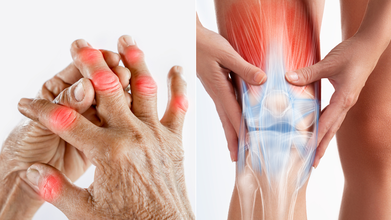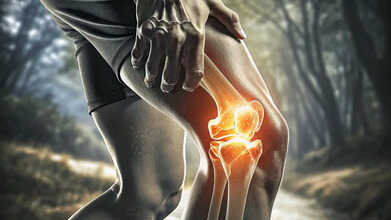- Health Conditions A-Z
- Health & Wellness
- Nutrition
- Fitness
- Health News
- Ayurveda
- Videos
- Medicine A-Z
- Parenting
- Web Stories
UK Health Officials Issue A Public Warning And Safety Guidelines Against These Bugs That Cause Lyme Disease

(Credit-Canva)
As an unexpected wave of heat hits the UK, many people have been concerned regarding not just heat-illnesses, but also other issues that arise mostly in the summer season.
The UK Health Security Agency (UKHSA) has issued a public warning against a small, almost invisible threat that could send you to the hospital. Taking simple steps can help you avoid these bugs that could leave you with flu-like symptoms lasting for weeks.
The Hidden Danger: Ticks
Ticks are small bugs often found in woods, grassy areas, and moorlands. The reason why the volume of these bugs is more prevalent in these grassy areas is because it is easier to find and feed off other creatures there. These bugs are known to spread Lyme disease, a bacterial infection. You get it when a tick bites you and feeds on your blood, which can lead to flu-like symptoms. Not all ticks carry Lyme disease, though. It's usually easier to treat if caught early, but if it goes unnoticed, problems can worsen, causing joint pain, nerve issues, and memory problems.
Lyme Disease Treatment
The chances of getting sick are fairly low, as not all ticks carry the bacteria that cause Lyme disease. If you've been bitten, keep a close eye on the bite area for symptoms, especially the well-known "bullseye" rash. This rash can appear up to three months after a bite, but usually shows up within one to four weeks.
If a doctor thinks you might have Lyme disease, they'll prescribe antibiotics. The type you get depends on your symptoms, and you might need to take them for up to 28 days. It's very important to finish the entire course, even if you start feeling better. For severe symptoms, you might be sent to a hospital specialist to receive antibiotics directly into a vein.
A small number of people who are treated for Lyme disease continue to have symptoms like tiredness, aches, and low energy for years. These symptoms are often compared to conditions like fibromyalgia and chronic fatigue syndrome.
What to Do If You're Bitten
Tick bites might not hurt at first because ticks put a numbing substance into your skin, so you might not even notice you've been bitten. If you do find a tick, it's important to take it out the right way: use fine-tipped tweezers or a special tick-removal tool, grasp the tick as close to your skin as you can, and pull it slowly upwards without squeezing it. Never try to pull it out with your fingers, as this can leave part of the tick in your skin and cause an infection. After removing the tick, clean the bite area with antiseptic or soap and water.
Simple Prevention Tips
Health officials recently shared advice on how to protect yourself from these tiny parasites. They suggest simple actions are best to prevent tick bites:
- Regular checks are your best defense. While you're outside, brush off any ticks you spot right away.
- Do another check when you get home. Focus on exposed skin and any clothes where these bugs might be clinging.
- Don't forget to check children and pets, as they can't check themselves.
- Use an insect repellent that specifically prevents ticks.
- Wear long sleeves and long trousers when outdoors to reduce direct skin contact.
- When possible, stick to clearly marked paths and avoid brushing against plants where ticks might be hiding.
Not Just Respiratory Diseases, Air Pollution Can Also Trigger Rheumatoid Arthritis, According To Doctors

Credits: Canva
Air pollution levels in Delhi rises after the festive celebrations in October, and due to the cold weather, the polluted air looms around us. While all of us are aware of the respiratory illnesses caused by air pollution, a new study has now shown that it could also trigger rheumatoid arthritis.
At the 40th annual conference of the Indian Rheumatology Association (IRACON 2025), which was held at the Yashobhoomi in Dwarka, with leading rheumatologists present there, revealed that there is plenty evidence that shows how toxic air and PM2.5 pollution could fuel a surge in cases of rheumatoid arthritis across Delhi-NCR.
What is rheumatoid arthritis?
It is a chronic autoimmune disease that causes pain, swelling, stiffness, and warmth in the joints and affects mostly small joints of hands and feet in a symmetrical pattern. It occurs when the immune system attacks the body's own tissue, particularly the lining of the joints and leads to inflammation or even damage to cartilage and bones.
What Are The Experts Saying?
The experts have pointed out that autoimmune diseases like rheumatoid arthritis was traditionally linked to genetics and immune system dysfunction. However, now it is increasingly being associated with environmental factors too. One of the biggest trigger is air pollution. As per the current estimates, the condition affects 1% of India's adult, and pollution adds fuel to the fire. The experts suggested with pollution being on the rise, the cases are expected to increase too.
"When pollution levels are high, the patients who do well otherwise, their condition also worsen… We are observing a rise in RA cases in patients living in polluted areas with no family history or genetic predisposition to autoimmune disease,” said Dr Uma Kumar, Head of Rheumatology at AIIMS Delhi. She also pointed out that most of these patients are between the age 20 to 50. “This is a public health emergency we can no longer ignore,” she said.
Dr Pulin Gupta, who is a professor and rheumatologist at the Dr Ram Manohar Lohia Hospital said, “What we are witnessing is not just a increase in cases of RA but these cases are also more severe… Reduced green spaces in urban areas are worsening the problem, depriving residents of protective environmental buffers.”
He also said that studies have now shown a strong association between exposure to PM2.5, nitrogen oxides, and ozone with increased risk of rheumatoid arthritis cases. "Living near busy roads, which means constant traffic-related pollution, has also been linked to higher RA risk,” he said.
What Is The Study Experts Are Basing Their Opinions At?
Dr Gupta pointed out the study that was the base of this claim of the relationship between pollution and rheumatoid arthritis. The 'landmark study' is published in the European Medical Journal, 2025, which has provided strong genetic evidence that connect air pollution to autoimmune diseases, including rheumatoid arthritis.
The study has used two-sample Mendelian randomisation approach and identified significant causal links between common pollutants and immune system dysfunction. It has also highlighted environmental damage as a crucial driver in the rise of these diseases.
Dr Gupta pointed out that Delhi is one of the top 10 most polluted cities in the world and has thus emerged as a hotbed of concern.
“Pollution is rewriting that narrative… turning healthy individuals into patients. The fact that young people with no family history are developing RA should set alarm bells ringing," said Dr Neeraj Jain, Scientific Chairman and Vice Chairman, Department of Rheumatology at Sir Ganga Ram Hospital.
“European cohorts similarly reported that people living in highly polluted cities had significantly higher morbidity related to autoimmune disorders. These findings mirror what doctors are now observing… with Delhi residents facing a double blow of respiratory distress and autoimmune flare-ups,” he said.
New Developments Like Lower Doses of Radiation And Drug-filled Cartilage Could Help In Arthritis Treatment

Credits: Canva
Each year on October 12 the world observes Arthritis Day to bring attention to the medication condition and ways to find out to prevent and to treat it as there is no cure. However, apart from the traditional treatments like medication, physical therapy, lifestyle changes, and surgery to manage symptoms, there have ben new treatments in the recent times too. Before jumping into what those treatments are, let us first understand what is arthritis?
It is a medical term for joint pain, inflammation, and stiffness, with over 100 different types. It also includes osteoarthritis and rheumatoid arthritis.
Osteoarthritis: It is a progressive, degenerative joint disease where the protective cartilage cushioning the ends of the bones breaks down. It then causes pain, stiffness, swelling and reduced mobility and affects the hands, knees, hips and spine.
Rheumatoid Arthritis: It is a chronic autoimmune disease that causes pain, swelling, stiffness, and warmth in the joints and affects mostly small joints of hands and feet in a symmetrical pattern. It occurs when the immune system attacks the body's own tissue, particularly the lining of the joints and leads to inflammation or even damage to cartilage and bones.
What Are The New Treatment On Arthritis?
As per the multiple new studies present at the American Society of Radiation Oncology (ASTRO), 2025, researchers from Korea, the US, and Germany reported that mild doses of radiation can significantly reduce pain and also improve mobility in patients with osteoarthritis.
Radiation Therapy For Arthritis
In South Korea, a randomized clinical trial was conducted with 114 volunteers, who had knee arthritis, and were treated with 3 Gy of radiation, which had spread over six sessions. Researchers also noticed that 70% of participants experienced meaningful improvement in pain, function and overall functioning. This was way higher than the 42% improvement seen in the placebo group.
Low-dose radiation is already common in the Europe. However, strong randomized data was limited till now. Dr Byong Hyuck Kim of the Seoul National University, who led the study also emphasized that here, the radiation doses are 10 to 20 times lower than cancer therapy levels and targets only the joints far from the vital organs.
Artificial Cartilage Helps Arthritis
Researchers from the University of Cambridge designed an artificial cartilage that could help with arthritis treatment. This 'cartilage' can sense tiny changes in the body, including arthritis flare-up and release drugs exactly when and where they are needed.
The 'cartilage' is squishy in nature and can be loaded with anti-inflammatory drugs that are released in response to small changes in pH in the body. During arthritis flare-up, joint becomes inflamed and more acidic. The 'cartilage' becomes softer as the change in pH is noticed, especially when the acidity increases and it triggers the release of drug molecules that can be encapsulated within its structure.
The entire study is published in the Journal of American Chemical Society.
World Arthritis Day 2025: Date, Theme, Significance And History Explained

Credits: Canva
Every year, people across the world unite on World Arthritis Day to spread awareness about arthritis and related disorders. Observed annually on October 12, the day aims to draw attention to the everyday challenges faced by those living with arthritis, encourage early diagnosis, and promote better medical care and support systems.
As World Arthritis Day 2025 approaches, it’s a timely reminder to learn about its theme, importance, and the role each of us can play in improving the lives of those affected.
Why World Arthritis Day Matters
Arthritis is often mistaken for a simple case of joint pain, but it is far more complex. It includes a wide range of conditions that can impact a person’s mobility, independence, and overall well-being. One of the main goals of World Arthritis Day is to break these misconceptions, spread accurate information, and raise awareness that arthritis can affect anyone, regardless of age.
Raising awareness also encourages timely medical consultation, physiotherapy, and healthier lifestyle choices that can help manage symptoms and prevent complications.
World Arthritis Day 2025 Theme
The theme for World Arthritis Day 2025 is “Realizing Your Dreams” or “The Courage to Dream.” This year’s message highlights the importance of personal aspirations and resilience among people living with rheumatic and musculoskeletal diseases (RMDs). It inspires individuals to pursue their dreams while encouraging collaboration between patients, doctors, and advocates to turn those dreams into reality.
The theme serves as a reminder that arthritis is not just a physical condition, it is about preserving one’s independence, dignity, and quality of life.
When Is World Arthritis Day Celebrated?
World Arthritis Day is marked every year on October 12 around the globe. In India too, this day is recognised and observed to underline the importance of awareness and education about arthritis. With lifestyle changes and rising stress levels, arthritis is now being diagnosed in younger people as well, making awareness even more vital.
Ways to Raise Awareness on World Arthritis Day 2025
Spreading awareness is not limited to medical professionals or organizations. Every individual can help in small but meaningful ways. Some simple ideas include:
- Educational Programs: Schools, offices, and community groups can organize sessions to teach people about arthritis symptoms and preventive care.
- Social Media Campaigns: Sharing real-life stories, verified facts, and official theme posters can reach thousands online.
- Community Events: Walkathons or charity runs can raise both funds and awareness.
- Free Health Camps: Clinics and hospitals can offer free joint check-ups to encourage early diagnosis.
These collective efforts ensure that arthritis is not ignored or misunderstood, but openly discussed and addressed.
Tips for Living with Arthritis
Awareness is the first step, but supporting those who live with arthritis every day is just as important. Here are some ways to help manage the condition and maintain a good quality of life:
Stay Active, but with Care
Choose gentle exercises such as walking, yoga, or swimming to keep joints flexible and reduce stiffness without straining them.
Eat a Balanced Diet
Include anti-inflammatory foods such as leafy greens, fatty fish rich in omega-3, nuts, and olive oil to help ease inflammation.
Get Enough Rest
Quality sleep helps the body recover. Avoid overexertion but stay active enough to prevent stiffness.
Use Supportive Tools if Needed
Walking sticks, braces, or other assistive devices can reduce stress on joints and make movement easier.
Maintain a Positive Outlook
Joining arthritis support groups or connecting with others who share similar experiences can provide motivation and emotional support.
For those seeking specialized treatment, visiting a reputed multispeciality hospital in Coimbatore can help patients receive comprehensive arthritis care, from diagnosis to therapy and rehabilitation, under one roof.
© 2024 Bennett, Coleman & Company Limited

